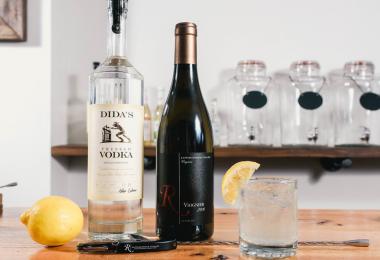Although Australian wines dominate Australia’s market, exporters are finding it an increasingly attractive place to do business. Not only is the population one of the world’s wealthiest, but Australians are outward looking and keen to try new things. James Lawrence interviews experts who do business there.
Vitaliano Tirrito
export director,
Terra Moretti Vino, Italy
My company represents a small portfolio of Italian wine brands – we started exporting Bellavista to Australia more than ten years ago, although Contadi Castaldi and Petra have only been in the market for a short time. The market today is generally stable but there is still room for growth since many brands and appellations are not present in Australia yet. Retail sales are static, while the on-trade is in a state of constant evolution. Local gastronomy in Australia is developing dramatically and so is wine knowledge; distinctive European grapes and Italian flavours spike local curiosity, so the on-trade is a key focus for us. The retail sector is utterly saturated and dominated by domestic wines. It is also polarised between little independent wine shops and a very few big retail chains, leaving little space for mid-sized operations. The buoyant on-trade, enhanced by growing levels of immigration, is far more open to non-Australian wines.
However, I must concede that the market is not growing at the rate I expected. Considering the geographical size and maturity of the Australian market, we expected faster growth. The vastness of Australia remains the main barrier and you need to consider the economy and the habits of each state separately. But as a young country rich in natural resources, there is enormous potential for future development. It boasts the largest percentage of Italian immigrants after the US and Canada. This is a very contradictory market; a mix of tradition and innovation, veterans and newcomers. You can still find the most traditional products, brought here a couple of generations ago by southern Italian traders who basically missed home tastes and started an import business. They exist alongside the most innovative labels and ideas developed by young Australian entrepreneurs. Geographically, populations are concentrated in the main urban areas and so is demand. Basically, we are talking about Sydney and Melbourne for our wines today; however, I have observed a rising interest in Queensland. Perth is also considered a healthy market for imported wine styles, although sales of Italian wines are currently negligible. My advice to prospective brands is to be wary of relying on the obvious markets like Sydney, which are becoming overcrowded, and understand how challenging the on-trade can be. It takes a lot of time and money to build a reputation before another trend arrives and dominates the scene. But don’t be scared of the distance and Australia’s domestic wine industry. Australians are wine lovers and travellers.
Letizia Patanè
export manager Asia/Australia,
Passopisciaro, Italy
Passopisciaro entered the Australian market in 2010. What attracted us was the maturity of this market; exporting to a wine-producing country carries net benefits as well as challenges. I’ve found that sommeliers are interested in trying new grapes and learning more about Italian varieties, as are private customers. I really think that the market is in constant growth for indigenous Italian grapes, although it’s more difficult for Bordeaux wines to thrive here since Australians are saturated with home-grown versions of Bordeaux blends. You have to provide consumers with something they cannot easily or widely access from their own wineries. With regards to our Sicilian estate, one of the biggest changes I have seen in the past couple of years is the number of people who come to visit us every year. Australian foreign tourism is booming. They return to Australia full of enthusiasm for our wines. I’m very happy with our performance in the country.
Jaap Sonnemans
international brand manager,
Maison Saint-Aix, France
We entered the Australian market in 2012, after signing a contract with a small importer in Melbourne. Sales are in gradual growth as a dry style of rosé is still fairly new to the Australian public. Yet Australian producers are starting to wake up and take rosé as a category more seriously –rosé has until now always been ‘bottom of the barrel’ leftover juice for Australian winemakers. There is also a new trend which is starting to happen in Australia which is the ‘brosé’ phenomenon, which means that more and more men dare to drink, order and buy a bottle of rosé. In terms of sectors, both retail and on-premises segments are still familiarising themselves with Provence rosé and are both growing at a gradual pace. But this is a market full of contradictions: it’s quite dynamic but also still immature as there is not a great knowledge about Provence as yet. Some IGP wine producers from France are starting to confuse the trade and general public by selling cheap Vin de Pays into Australia, calling them Provence wines and selling them at Provence prices.
Today our sales base is mainly Sydney and Melbourne. Besides that, chains like Dan Murphy’s, Woolworths Liquor, BWS, Liquorland and Vintage Cellars dominate the market and are important for a better understanding of Provence rosé and building brands. The key challenge concerns exchange rates; Australian dollars and the euro have been all over the place. Also, dealing with unscrupulous importers who don’t pay their bills and pretend they know what they are doing when it comes to wine imports. You also obviously need sufficient volume to enter this market and not leave Australia with the leftovers after the European summer. So do your homework first before you enter this market.
Simon Lee
marketing and sales manager,
Greenstone Vineyards, Australia
On average the broader Australian market remains stable, with no significant or noteworthy shift in retail or on-premises sales. There is, however, a long-term increase in spend per bottle across both channels, indicating wine drinkers are drinking less but demanding better quality. Imported wine (excluding New Zealand) still occupies a small share of the overall market, although over the past decade we’ve certainly seen an increased market presence of European sparkling wines, including Champagne, (and) French rosé and Italian Pinot Grigio. This has been driven mainly by the popularity of these categories and a relatively strong Australian dollar. In the past few years, rosé has experienced a real boom as well as Moscato and Prosecco, either domestically produced or imported. Sauvignon Blanc (mainly driven by NZ) still accounts for the lion’s share of white wine sales; however, this dominance is slowly being eroded as drinkers move away from Sauvignon Blanc to other white varietals such as Pinot Grigio and Chardonnay. Another observation is the perceived decline in brand loyalty as emerging drinkers opt for diversity over regularity, compounded somewhat by the increased pressure on the wine category by other ‘crafted’ options such as beer and spirits like craft gin.
In recent years, I’ve noticed a significant increase in imported wines. Australians have always been great travellers and this has only increased as travel becomes more accessible and more people are exposed to other cultures. This, coupled with a strong dollar in recent years, has assisted in driving growth in imported wine to Australia with the prominent players being France, Italy and Spain and more recently, to a lesser degree, USA, South American producers and South Africa. But I predict this to slow as the Australian dollar weakens.
Interviews by James Lawrence
This article first appeared in Issue 5, 2019 of Meininger's Wine Business International magazine, available in print or online by subscription.
You can also sign up to our free newsletter








